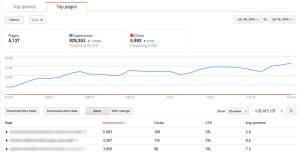Most bloggers would agree that high-quality content creation requires a significant investment in time and energy. Because of this sunk cost associated with any existing content on your website, it’s crazy that bloggers don’t invest additional resources improving, optimizing and ranking underperforming pages. This is especially true when certain posts are just shy of reaching the first page of Google’s search results, where they could be earning you a return on your investment.
With a few of the tactics below, digital marketers can make sure that every piece of content they publish is generating traffic, leads, and ultimately revenue.
Use Google’s Webmaster Tools To Optimize Headlines and Keywords
Are you ever surprised at some of the keywords a post ends up ranking for? Even when you complete keyword research, decide to target a specific phrase, and optimize the post to rank for that term, you sometimes end up getting traffic from unexpected terms. If you find a post that isn’t ranking for your targeted keyword due to higher than anticipated competition, then maybe it’s better to repurpose the post and optimize it for another term.
To find these types of posts, you will need to access Google’s Webmaster Tools. Click on the “Search Analytics” tab on your Dashboard, or go under “Search Analytics” at the left and choose “Search Analytics” there.

I prefer the old “Search Queries” report, so I click on the link towards the top of the page. Now you need to click on the “Top Pages” tab, sort by “Impressions”, and expand the tabs you are interested in analyzing. If you have a large blog, instead of working within your browser, you may want to click on “Download This Table”.

Ultimately what you are looking for are pages that have high impression counts but low clickthroughs (CTRs). These pages constitute your highest potential content because they are getting exposure in Google’s rankings but aren’t high enough to get more clicks. Optimizing these pages could easily earn you significantly more traffic.
Here are a few ways to optimize your titles and on-page SEO:
- Use a hyphen or colon. When writing a title, I create for both Google and humans. The first half of the title is usually an exact match keyword phrase and the second half is a killer description to get the reader’s attention. For example, if I wrote an article about affiliate marketing, I would title it “CPA Marketing – How To Increase Your Affiliate Marketing Revenue By 137%”.
- Add more content. When targeting additional keywords, it may be helpful to add more content that directly addresses the related topic, thereby increasing your post’s relevance. In doing so, you may rank for even more long-tail terms.
- Target lower competition terms. If you’re a small business owner learning how to build a blog, you should not be targeting high-volume, high-competition keywords. This strategy will quickly exhaust your resources with little results. Always start with easy terms to build traffic and recognition, and as your blog’s backlink profile strengthens, target more valuable keywords. If a page is underperforming, this might be the underlying issue.
Internal Linking – Connecting Old and New Content
Internal linking is easily overlooked and underappreciated. Not only does internal linking old pages to new and new pages to old help decrease bounce rate, increase time on site, multiply your email subscribers and promote conversions, it can provide a slight boost in your on-page SEO and rankings.
In an algorithm that takes into account over 200 ranking signals, each given a different weight, a small boost in one category that pushes you up a position can get you double the traffic from a single keyword.
While internal linking is mostly self-explanatory, here are a few guidelines:
- Find older, authoritative posts that rank high and add internal links to newer, high-value posts.
- Don’t use the same exact match anchor text to link to a page dozens of times. Diversify your internal links and incorporate long-tail keywords.
- Internal linking offers subtle results. Even if the tactic doesn’t increase your rankings, it can provide a better user experience, keep readers on your site longer, and most likely improve conversions.
Other Tactics To Leverage Old Content
While the suggestions above constitute the easiest adjustments you can make overnight, there are other ways to grow your blog using your existing content. Here are a few more ideas:
- Outreach marketing. On-page SEO is important, but a campaign to increase your blog’s exposure and earn natural links will boost not only the page you are marketing but improve your entire site’s authority.
- Share your content more than once. Perhaps you’ve developed a great resource that you’ve recently updated. Be sure to re-share old work that stands the test of time, but know the best times to post on social media so your content isn’t buried or unseen.
- Create different forms of multimedia. Bloggers and internet users absolutely love images, graphics and different types of media. Creating a quality infographic using your existing content may be the solution to grabbing people’s attention, increasing shares, and earning links.
 Gary Dek is a professional blogger, SEO expert, and freelance writer. He is the founder of StartABlog123.com as well as a dozen other niche websites and specializes in content marketing and link building strategies. Previously, Gary was an investment banking and private equity analyst.
Gary Dek is a professional blogger, SEO expert, and freelance writer. He is the founder of StartABlog123.com as well as a dozen other niche websites and specializes in content marketing and link building strategies. Previously, Gary was an investment banking and private equity analyst.

